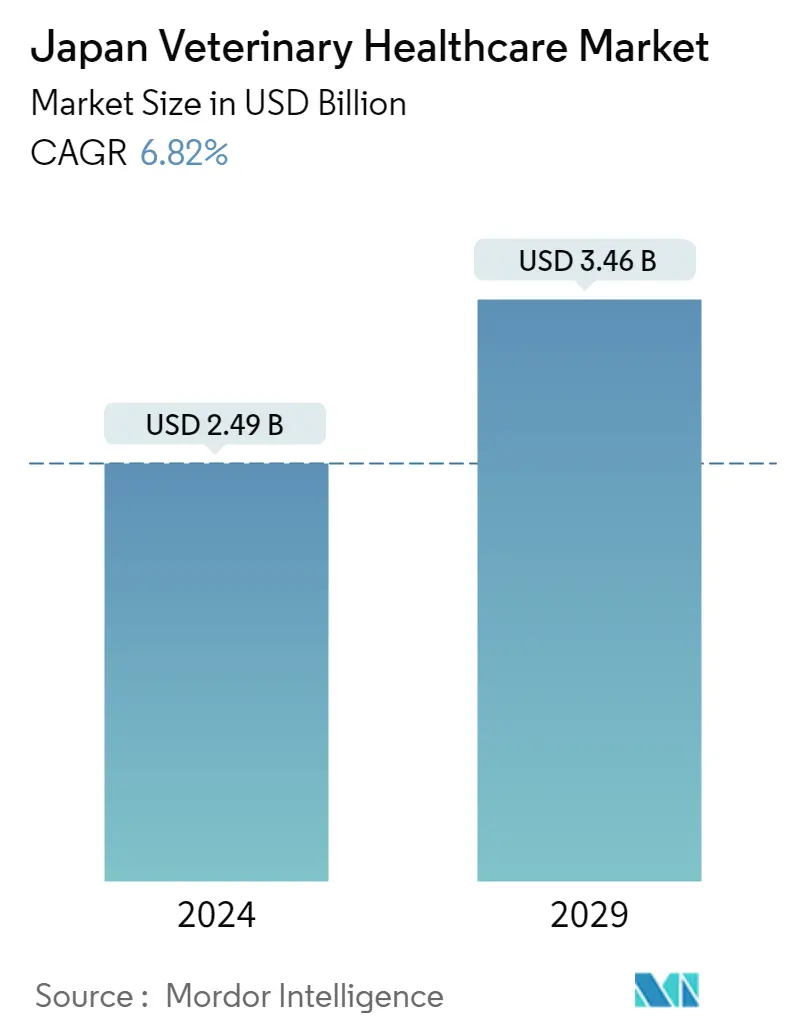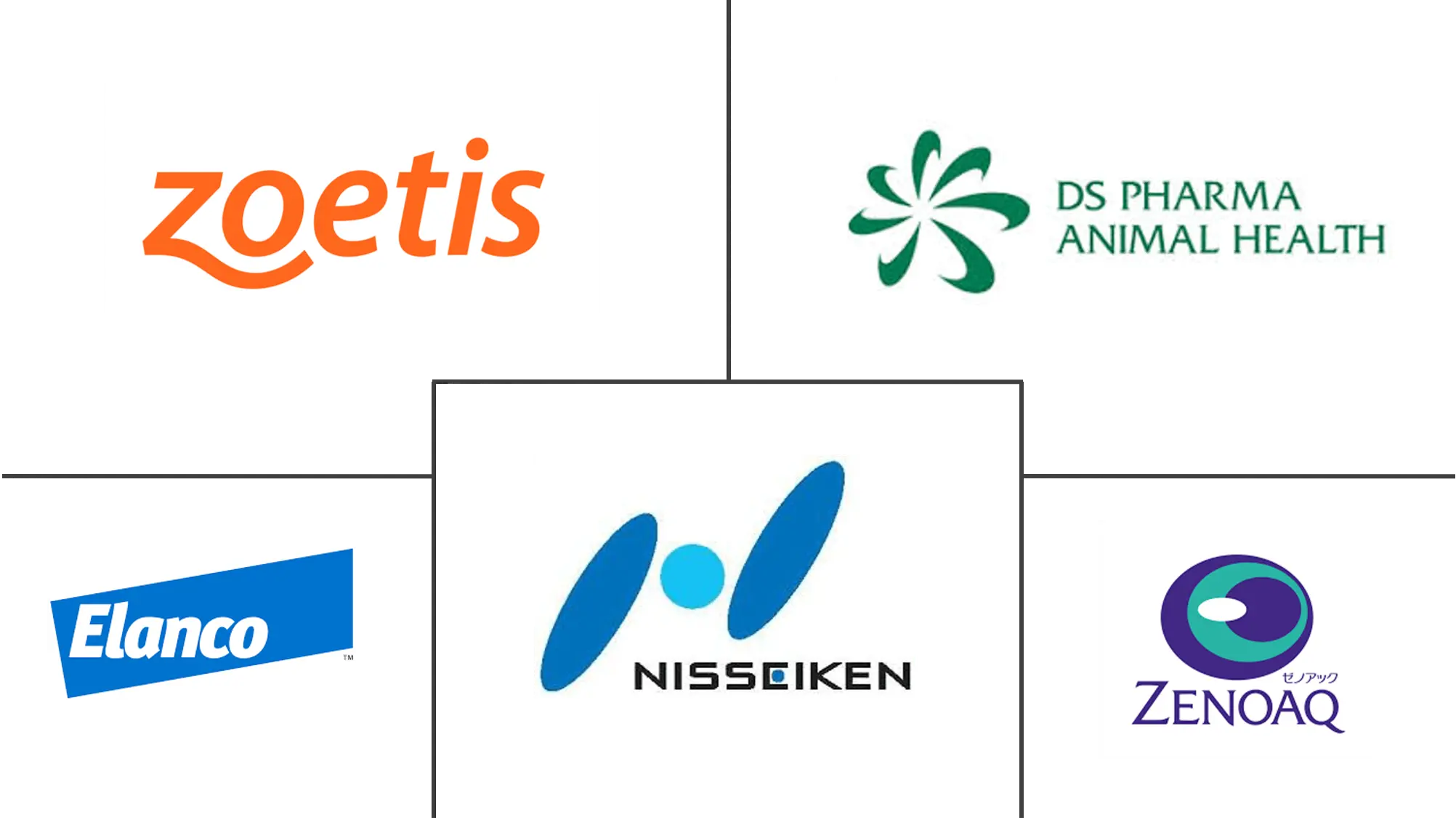Market Size of Japan Veterinary Healthcare Industry

| Study Period | 2019 - 2029 |
| Base Year For Estimation | 2023 |
| Market Size (2024) | USD 2.49 Billion |
| Market Size (2029) | USD 3.46 Billion |
| CAGR (2024 - 2029) | 6.82 % |
| Market Concentration | High |
Major Players
*Disclaimer: Major Players sorted in no particular order |
Japan Veterinary Healthcare Market Analysis
The Japan Veterinary Healthcare Market size is estimated at USD 2.49 billion in 2024, and is expected to reach USD 3.46 billion by 2029, growing at a CAGR of 6.82% during the forecast period (2024-2029).
The outbreak of COVID-19 has impacted all industries including Japan's veterinary healthcare market. Pet parents are advised to keep a safe distance from their pets in order to reduce the risk of contamination and maintain hygiene. There has been difficulty in moving animal products such as milk, eggs, meat to markets. The restriction were been implemented on the seasonal border crossing with ruminants. Pet adoptions increased during this pandemic situation. A 2020 survey conducted by the Japan Pet Food Association found a 15 percent increase in dog and cat ownership compared with the previous year 2019. There were an estimated 8.49 million dogs and 9.64 million cats being kept as pets in Japan as of October 2020. Several animal shelters, non-profit rescue organizations, private breeders, and pet stores observed increased consumer demand. Thus, the rising adoption of pets may drive the growth of the Japanese veterinary healthcare market in the longer term.
The risk from zoonotic diseases is fueling the market for Japan veterinary healthcare. Inter-Governmental Organizations and food production are making reforms to ensure health by the process of surveillance and vaccination, investing in R&D, and transfer with respect to vet health. Additionally, advanced technology leading to innovations in animal healthcare, increase in ownership of pet animals and increasing awareness about the health of animals consumed as food are also the factors responsible for the growth of Japan veterinary healthcare market.
Also, recent outbreaks such as pathogenic avian influenza (HPAI) is affecting quality life of poultry animals. For instance, in November 2021, according to the news article, Japan has confirmed the highly pathogenic bird flu subtype H5N8 was detected at a poultry farm in the third outbreak of avian influenza in the country. Additionally, As per the news article published in December 2020 'Bird flu spreads to 10th Japanese prefecture', reported that around 5.5 million poultry had been slaughtered to contain virus. Also, Japan culled around 77,000 chickens over new bird flu outbreak in Tochigi. This unprecedented increase in such infectious disease prevalence has triggered companies to produce advanced vaccines and pharmaceuticals.
However, increasing costs of animal testing and veterinary services, lack of infrastructure and funding and use of counterfeit medicines are restraining the growth of Japan veterinary healthcare market.
Japan Veterinary Healthcare Industry Segmentation
As per the scope of this report, the Japan veterinary healthcare market is growing, comprising therapeutic products and solutions for companion and farm animals. Companion animals can be tamed or adopted for companionship or as house/office guards, and farm animals are raised for meat and milk-related products. Companion animals include canine, feline, and equine. Farm animals are bovine, poultry, and porcine. The Japan veterinary healthcare market is segmented by Product (therapeutics and diagnostics) and animal type (dogs and cats, horses, ruminants, swine, poultry, and other animals). The report offers the value (in USD million) for the above segments.
| By Product | |||||||
| |||||||
|
| By Animal Type | |
| Dogs and Cats | |
| Horses | |
| Ruminants | |
| Swine | |
| Poultry | |
| Other Animals |
Japan Veterinary Healthcare Market Size Summary
The Japan veterinary healthcare market is poised for significant growth, driven by increasing pet ownership and heightened awareness of animal health. The market is experiencing a surge in demand for veterinary services and products, fueled by the rising adoption of pets during the COVID-19 pandemic. This trend has led to a greater focus on pet healthcare, as more households welcome dogs and cats into their homes. Additionally, the market is benefiting from advancements in veterinary technology and innovations in animal healthcare, which are enhancing the quality and efficacy of veterinary services. The growing concern over zoonotic diseases and the need for robust surveillance and vaccination programs are further propelling the market's expansion. Despite challenges such as the prevalence of infectious diseases affecting livestock, the demand for advanced vaccines and pharmaceuticals is on the rise, as companies strive to address these health concerns.
The vaccines segment within the Japan veterinary healthcare market is expected to experience steady growth, supported by innovations and increased investments in animal health. The availability of advanced vaccines, including those with genetically engineered components, is contributing to the segment's expansion. Key market players, such as Kyoritsu Seiyaku Corporation, are offering a wide range of vaccines to prevent various animal infections, thereby enhancing their market presence. The market is also witnessing collaborations, such as the partnership between Verovaccines GmbH and a Japanese pharmaceutical company, aimed at developing cost-effective and safe vaccines for animal health. While the market is dominated by a few major players, there is a growing presence of new entrants, which is expected to lead to a more competitive landscape. Overall, the Japan veterinary healthcare market is set to grow steadily, driven by technological advancements, increased pet ownership, and a strong focus on animal health and well-being.
Japan Veterinary Healthcare Market Size - Table of Contents
-
1. MARKET DYNAMICS
-
1.1 Market Overview
-
1.1.1 Advanced Technology Leading to Innovations in Animal Healthcare
-
1.1.2 Increasing Productivity at the Risk of Emerging Zoonosis
-
-
1.2 Market Restraints
-
1.2.1 Increasing Cost of Animal Testing and Veterinary Services
-
1.2.2 Use of Counterfeit Medicines
-
-
1.3 Porter's Five Force Analysis
-
1.3.1 Threat of New Entrants
-
1.3.2 Bargaining Power of Buyers/Consumers
-
1.3.3 Bargaining Power of Suppliers
-
1.3.4 Threat of Substitute Products
-
1.3.5 Intensity of Competitive Rivalry
-
-
-
2. MARKET SEGMENTATION (Market Size by Value - USD Million)
-
2.1 By Product
-
2.1.1 By Therapeutics
-
2.1.1.1 Vaccines
-
2.1.1.2 Parasiticides
-
2.1.1.3 Anti-infectives
-
2.1.1.4 Medical Feed Additives
-
2.1.1.5 Other Therapeutics
-
-
2.1.2 By Diagnostics
-
2.1.2.1 Immunodiagnostic Tests
-
2.1.2.2 Molecular Diagnostics
-
2.1.2.3 Diagnostic Imaging
-
2.1.2.4 Clinical Chemistry
-
2.1.2.5 Other Diagnostics
-
-
-
2.2 By Animal Type
-
2.2.1 Dogs and Cats
-
2.2.2 Horses
-
2.2.3 Ruminants
-
2.2.4 Swine
-
2.2.5 Poultry
-
2.2.6 Other Animals
-
-
Japan Veterinary Healthcare Market Size FAQs
How big is the Japan Veterinary Healthcare Market?
The Japan Veterinary Healthcare Market size is expected to reach USD 2.49 billion in 2024 and grow at a CAGR of 6.82% to reach USD 3.46 billion by 2029.
What is the current Japan Veterinary Healthcare Market size?
In 2024, the Japan Veterinary Healthcare Market size is expected to reach USD 2.49 billion.

